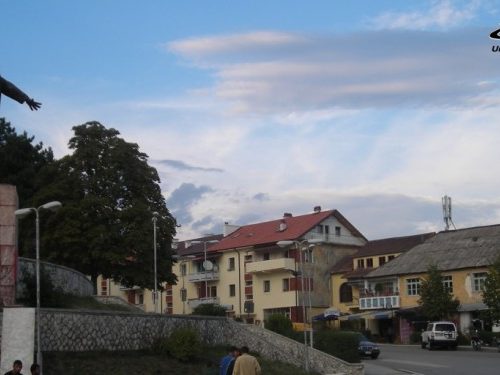Butrint
Butrint was an ancient Greek and later Roman city in Epirus. In modern times it is an archeological site in Sarandë District, Albania, some 14 kilometres south of Sarandë and close to the Greek border. It was known in antiquity as Bouthrōtios in Ancient Greek and Buthrotum in Latin. It is located on a hill overlooking the Vivari Channel and part of theButrint National Park. Inhabited since prehistoric times, Buthrotum was a city of the Greek tribe of the Chaonians, later a Roman colony and a bishopric. It entered into decline in Late Antiquity, before being abandoned during the Middle Ages after a major earthquake flooded most of the city.
Dajt Mount
Dajt Mount is a mountain in central Albania, to the east of Tirana. Its highest peak is at 1,613 m (5,292 ft). In winter, the mountain is often covered with snow, and it is a popular retreat to the local population of Tirana that rarely sees snow falls. Its slopes have forests of pines, oak and beech. Dajt Mountain declared “National Park” is today an area of about 3333 ha. It is under the jurisdiction and administration of Tirana Forest Service Department.
Karavasta
The Karavasta Lagoon is the largest lagoon in Albania and one of the largest in theMediterranean Sea. It is separated from the Adriatic Sea by a large strip of sand. The lagoon is part of the Divjake-Karavasta National Park. It was elected as an area of international importance, protected by the Ramsar Convention of 29 November 1995.
Lura
Lura is a park located in Lurë municipality in north-eastern part of Albania. It includes Kunora e Lurës which reaches a height of 2,119 m (6,952 ft) above sea level, the highest peak of Lurë Mountains.The most common type of tree is the Beech which is found on altitudes between 900 and 1,000 m (2,953 and 3,281 ft) to 1,900 and 2,000 m (6,234 and 6,562 ft). On altitudes between 1,600 and 1,700 m (5,249 and 5,577 ft) Black Pine[disambiguation needed] are abundant and on altitudes between 1,700 and 2,000 m (5,577 and 6,562 ft) separate Red Pineand White Pine[disambiguation needed] are found on rocky slopes. These forests are home to the rare European Brown Bear,Eurasian Lynx, Eurasian wolf, European Pine Marten, Roe Deer and Capercaillie.A prime attraction for visitors to Lurë National Park and its mountains is its many lakes. The mountain range contains twelveglacial lakes which were formed during the Würm glacial period. These 12 lakes are home to the Smooth Newt and the Great Crested Newt. These lakes are found between 1,200 and 1,500 m (3,937 and 4,921 ft).
Llogora
Llogora is a national park in Albania declared since 1966 by the Albanian Government. The park covers an area of 1,010 hectares (2,500 acres) and protects the forests on the north side of the Llogara Pass between a height from 470 to 2,018 m (1,540 to 6,621 ft) above sea level. In the park can be found many black pine (Pinus nigra) trees, Bosnian Pines (Pinus heldreichii), Bulgarian fir, (Abies borisii-sign) andash trees (Fraxinus).Air currents around the area have caused trees to bend in many interesting shapes, like the Pisha e Flamurit.
Prespa
Prespa is the name of two freshwater lakes in southeast Europe, shared by Albania, Greece, and the Republic of Macedonia. Of the total surface area, 176.3 km2 (68.07 sq mi) belongs to the Republic of Macedonia, 46.3 km2 (17.88 sq mi) to Albania and 36.4 km2(14.05 sq mi) to Greece. They are the highest tectonic lakes in the Balkans, standing at an altitude of 853 m (2,798 ft).138 km2 (53.28 sq mi) drainage area; 42.5 km2(16.41 sq mi) surface area) and Albania (51 km2 (19.69 sq mi) drainage area; 4.3 km2 (1.66 sq mi) surface area).
Thethi
Theth is a national park in extreme northern Albania declared by government decree in 1966. It covers an area of 2,630 hectares and is located along the Theth River. The main attractions in the park are the Grunas Waterfall and the Lock-in Tower. Theth is adjacent to it and was declared a national park in 1966. It is proposed that the two parks, along with the areas in Montenegro andKosovo form a tri-border Bjeshket e Nemuna National Park.
Tomorr
Tomorr is a large mountain in southern Albania. Its highest peak, called Çuka e Partizanit, reaches a height of 2,416 m (7,927 ft). It is located east of the towns of Berat and Poliçan and the river Osum not far from the Canyon of Osum river.In antiquity the region of Tomorr (Greek: Άμυρον Amyron) was inhabited by the Dexari, a tribe of Epirus that belonged to theChaonian group of the northwestern Greeks.Albanian folklore tells how Tomorr came to be. The people believed that Tomorr was a giant that wanted to fight another giant named Shpirag for a young woman. The two giants killed each other and when hearing this the young woman cried and drowned in her own tears thus creating the river of Osum.Tomorr is of great spiritual importance to the local people. On the summit of the mountain a Bektashi shrine to the brother ofImam Husain, Abbas ibn Ali can be found. Each August thousands of faithful make pilgrimage to this shrine.Tomorr also offers many sports facilities such as skiing. For its importance and beauty the Albanian Government declared Tomorr a National Park. Tomorr Mountain National Park (Albanian:Parku Kombëtar i Malit të Tomorrit) covers an area of 4,000 hectares. Many endangered species are free to roam and live there.
Valbona
Valbona is adjacent to it and was declared a national park in 1996. is a national park in Albania declared by government decree in 1996. It covers an area of 8,000 hectares and is located along the Valbona Valley. A main attraction is the Valbona River flowing in the middle of the valley.Some attractions of the park include: Valbona Pass at 1811 meters of altitude, Cave of the Wind at 1942m, Zhapore Trail at 1624m, Beautiful alcoves at 1742m, Curraj i Eperm Church, Snow Cave.
Fir of Hotova
Fir of Hotova is a national park in southern Albania, in the region of Frashër, 35 km north-east of Përmet. The park has an area of 1,200 hectares. It takes its name from the Hotova Fir which is considered one of the most important Mediterranean plant relics of the country.
Qafë Shtama
Qafë-Shtama resides in the edge mountains Albania’s north ofTirana, about 25 kilometers east of Kruja. It is named after the Qafë-Shtamë passage. It has an area of 2000 acres, with a beautiful mountain scenery, some small lakes and major sources consisting mainly of pine forests. The national park was founded in 1996. It is becoming lately a popular attraction for hiking.The park’s name translates as pass Shtama. The road from Kruja to Burrel, runs through the park, on an altitude about 1250 meters.North of the pass road, the majority of the park is mostly undeveloped mountain land with forests, in which pine trees, and oak dominate. The black pines are up to 20 meters high and 60 years old – one of the main wood sources in Albania. The forests provide opportunities for retreat for brown bears, wolves,foxes, and various birds, actually being endangered from illegal deforestation. The highest points on which it rises steeply from the Pass to the north, are the Maja e Liqenit (1724 meters) and the off peak Maja i Rjepat e Qetkolës ( 1686 meters). Maja e Liqenit should not be confused with the peak with the same name in Sharr region of Kosovo. In the south of the park is adjacent to the Dajti National Park.The most significant source of water is called Kroi i Nenës Mbretëreshë (English:Source of the Queen Mother), known for its clean, clear and healthy water. The legend refers to the Albanian Royal Family, allegedly daily supply from this water source would be after of a laboratory in Vienna had awarded it as the best water in the country in 1932 by performing laboratory tests. The word Queen Mother probably points at Sadije Toptani, the mother of Ahmet Zogu, or Geraldine Apponyis, his wife, who had first visited Albania in 1937. Nena Mbretëreshë is a common name for the king’s mother. King Zog, was born in Mat region, originating from the east side of the pass. He is said to have also build a recreation villa in the area.The water is also collected and taken to a bottling plant, residing a little further down from the park entrance. The produced bottled mineral water is sold nationwide under the brand Qafshtama.On 29 April 1997, an underground bunker complex on the east side of the pass was house of a serious accident. An explosion would take place in the tunnels full of ammunition and weapons, stored in a military storage site during thecommunist era, which were dismantled in the 1990s. As a result of the collapse of public order, several people tried to disassemble metals for selling it, without applying any care or having proper military knowledge. As a result, there was an explosion in the tunnel. 23 people were killed, including many young people from a nearby village of Selishtë.
Shebenik
Shebenik is a protected national park located in the northeastern part of the Librazhd District,Elbasan County in central Albania. The park covers an area of 33,927.7 hectares and shares a border with the Republic of Macedonia. Elevations in the park vary from 300m to over 2,200m at the peak of Shebenik mountain, which, along withJablanica give name to the park. The park is one of Albania’s newest, created in 2008. Within the park region dwell a number of different species that are fast becoming rare in Albania, including the brown bear, gray wolf and the endangered Balkan Lynx. Further, the park is home to a number of endemic and rare plants. The nearest towns to the park are Librazhd andPrrenjas.On 21 April 2011, the PPNEA (Protection and Preservation of Natural Environment in Albania) research team got the first photo of an alive Balkan lynx living within the boundaries of the national park.
Karaburun – Sazan
Karaburun – Sazan proclaimed in 2010 is the only nationalmarine park of Albania. The park covers a marine area stretching 1-nautical-mile (1.9 km) along the coastlines of Karaburun Peninsulaand Sazan Island near the Bay of Vlora. The marine park is 16 kilometres (9.9 mi) long with a width varying from 3 to 4.5 kilometres (1.9 to 2.8 mi), and covering 12428 ha of surface in total. Karaburun Peninsula itself is a Managed Nature Reserve while Sazan Island is a military zone in Albania.
Korab
Korab is the highest mountainof Albania and the Republic of Macedonia, its peak forming a frontier between the two countries. The peak lies adjacent to theŠar Mountains. In 2011, Albania proclaimed the area as part of the Korab-Koritnik Natural Park.Mount Korab is also pictured in the coat of arms of the Republic of Macedonia.









